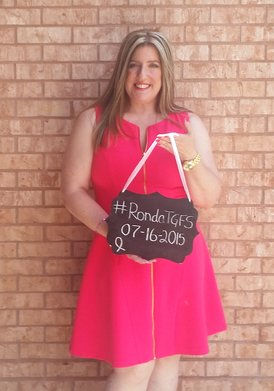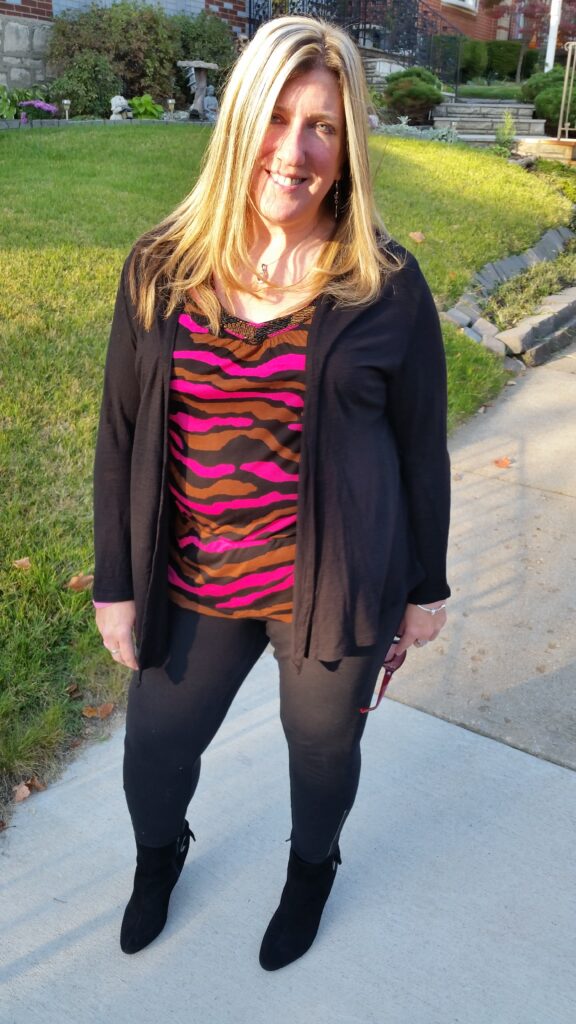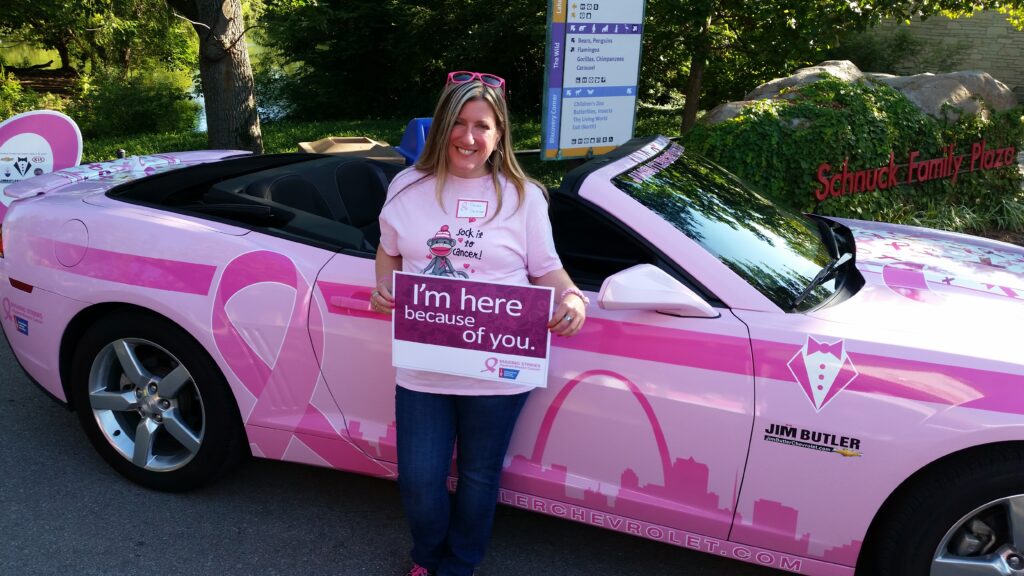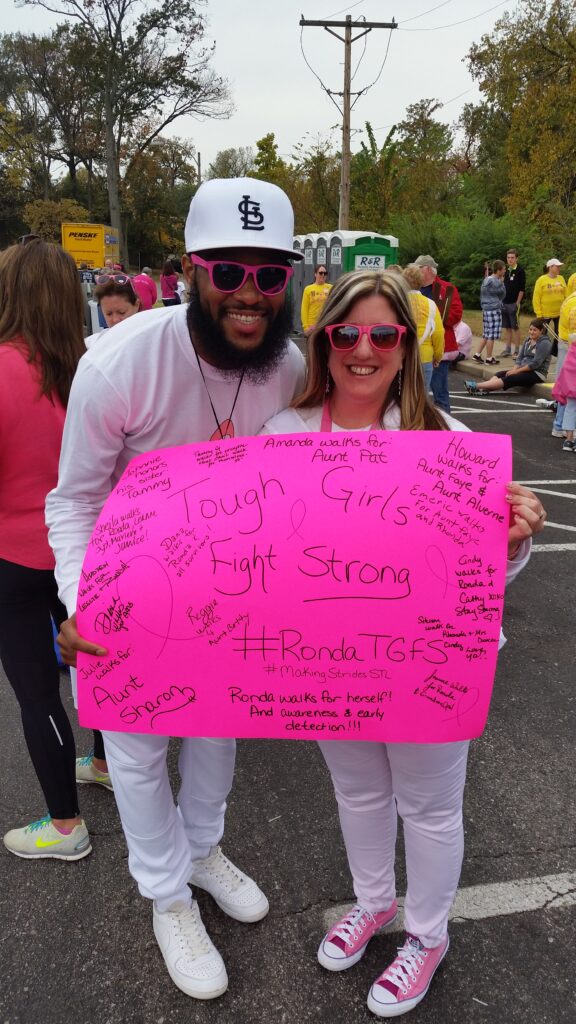Hi! My name is Ronda and I am a breast cancer survivor! On March 31, 2015, I was taking a walk in downtown St. Louis during my lunch break and noticed a St. Luke’s Hospital mobile mammography van parked just outside of my office building. I made a very impulsive decision that day to finally get my first mammogram at the age of 46. I didn’t even consider that this decision would change my life forever.

As I was getting x-rays, the technician (Kay) warned me several times that I might receive a “call-back”. She said this was very normal after the very first mammogram. A call-back just meant that additional tests were needed in order to rule out anomalies and establish a baseline set of x-ray images to compare future mammograms against. Okay, I could deal with that! A call-back really isn’t that big of a deal and nothing I really needed to worry about, right?
In April, I started to receive letters from the St. Luke’s Hospital women’s clinic. I also received a call and a letter from my primary physician. Sure enough, they needed some additional tests. I didn’t think much of the letters, because I just assumed that the tests were needed to establish the “baseline” set of images. The thought never even crossed my mind that there might actually be a real problem or concern. It was a busy time of year for me, and I decided to just ignore the letters. I could take care of additional testing some other time.
On June 11, 2015, I received a different type of letter that quickly changed my mind about procrastinating on getting additional tests. This letter required a signature, and the language in the letter was much more urgent and actually quite scary. Essentially, the letter warned me that it was not possible to definitively rule out that the findings from the mammogram were not cancerous in nature. The test results showed micro-calcification in my right breast, and although a majority of cases were non-cancerous, the only way they could know for sure was by running some more detailed diagnostic tests. Okay, now I got the message. This was much more serious than I originally thought. I immediately contacted the women’s clinic and scheduled an appointment for some diagnostic tests for June 16th.
“… without further tests, we cannot rule out cancer.”
I was at the women’s clinic for about 2 hours on June 16th. First, they took some additional x-ray images. My x-ray technician was Kay – the same lady that had been working the mobile van when I went in for my first mammogram! She remembered me, and continued to reassure me that this was normal and I shouldn’t worry. She started to take more x-rays, but what I found odd was that she took images of both breasts, and not just the right one which had micro-calcification. Apparently, there was a mass on my left breast that had the radiologist a bit concerned, as well. I was more frightened than ever, now. After my x-rays were taken, I was asked to sit in the waiting room while the radiologist examined the images. I was really shaken up at this point, and actually started to cry as I walked out of the x-ray room. Kay continued to reassure me and encouraged me to remain calm until they had more answers. She was very sweet.
After what seemed like an eternity, one of the technicians came out and took me back to another room. They wanted to do some additional tests on my left breast. The lumps were of concern, and the radiologist wanted to see how big they really were. After more poking and pushing and squishing, the technician stepped out of the room to get the radiologist. She wanted the radiologist to see the results and she said that the radiologist often likes to take a look herself using the ultrasound equipment. A few minutes later, the technician came back in with the radiologist, who proceeded to poke and push around some more and take images with the ultrasound machine. Finally, she told me that she was finished and I could sit up.
“I don’t want to frighten you…”
“I don’t want to frighten you…”, she started out by saying. Oh, boy. My heart seemed to stop beating altogether. Tears welled up in my eyes. I was already a nervous and emotional wreck. The floodgates were about to open, and I didn’t think I could hold the tears back anymore! I took a deep breath and tried to concentrate on every word that the radiologist was telling me. The radiologist proceeded to explain the findings to me. She was not overly concerned with the lumps in my left breast as the size, shape and edges indicated that they were likely fibroid, non-cancerous cysts. The micro-calcification in the right breast was a bit more concerning. Calcification deposits in breast tissue is quite common. About 80% of the time, microcalcification is benign. Microcalcification itself is not cancer, however, it can be an indicator for the presence of cancer in breast tissue.
“I do not want to wait for six months. What other tests can I have performed now?”
The radiologist recommended that I come back for additional tests in 6 months, and that we should just “wait and see” if there is any change in the pattern or size of the micro-calcification area, especially since 4 out of 5 times, the microcalcification is benign in nature.

What? You want me to wait for 6 months while I could possibly have some cancer cells growing in me?? I don’t think so!! I tears were falling at this point and I looked at the radiologist and said “I don’t want to wait.” My father had died at an early age from cancer, and my mother had lived with Leukemia for large part of her adult life. Whatever tests or biopsies or thing that needed to be done to ensure I didn’t have breast cancer – we needed to do that. I did NOT want to wait at all. The radiologist assured me that it was nothing to be overly concerned about, but if I wanted to be sure they would need to biopsy all three spots. I scheduled an appointment for June 19th – 3 days later. I didn’t want to mess around at all with this. I was truly scared at this point and absolutely terrified of the unknown.
On June 19th, I was at the Women’s Clinic at St. Luke’s for almost 3 hours. I had a sterotactic core biopsy on the right breast for the micro-calcification. This type of biopsy uses imaging to ensure that the needle gets into the middle of the micro-calcification cluster to draw out a good sample of tissue. I also had two other regular needle biopsies on the left breast. The latter two biopsies were actually the most painful and took the longest. It took more than an hour of pushing and poking, and several attempts before the radiologist could get the needle directly through to the middle of both cysts. I was so sore afterwards! My left breast swelled up and turned lovely shades of yellow and purple during the next couple of days. I couldn’t believe how incredibly painful the entire process was. They numbed my breast before the biopsies, but I could still feel a lot of the pushing that was going on. This was definitely an experience I would not wish on anyone, but I’m thankful that I decided to have the procedures performed.
When they sent me on my way on the 19th, I was encouraged to not stress or worry about the results. They would contact me within a few days once they had the final pathology reports back. The radiologist assured me that the two cysts in the left breast were very likely fibroid. They were hard, and very tough, and the more difficult it is to get the needle into the center of the cyst, the more likely it is that the cyst is not cancerous. This was promising news for me! Now, I just had to patiently wait until the results were back. That was not an easy task!
On June 23, 2015, I received a phone call and heard the words no woman ever wants to hear: “You have breast cancer.”
On June 23, 2015, I received a phone call and heard the words no woman ever wants to hear: “You have breast cancer”. I was initially diagnosed with DCIS (Ductal Carcinoma in Situ) Stage 0, which meant that the cancer was wholly contained in it’s originating place. I won’t sugar-coat this part of the story: I fell apart emotionally after hearing those four words. I was at work when I received the phone call. It was about 10:00am in the morning, and the nurse on the phone proceeded to schedule an appointment with one of their surgeons so that I could discuss options for surgery. I was numb, and I was in shock. I honestly don’t even remember much of what the nurse told me. I saw scribbled notes later that reminded me I had made an appointment for later that week. I had no idea who the doctor was. I only knew by the name that I would be seeing a female surgeon, but I had no idea what her qualifications were or anything else about her.

Later that day, after my brother (who works in the same department I do!!) helped calm my nerves at the Starbucks across the street, I contacted my primary physician’s office. He very quickly called me back and expressed frustration that he had not been informed of this diagnosis first. He gave me the name of a breast surgeon that he wanted me to contact instead of the surgeon the women’s clinic had scheduled me with. I completely trust my primary physician’s opinion, and knew that he would refer me to the best possible surgeon I could have.
I was able to get an appointment with Dr. Fahrner two days later on June 25th. Obviously, my doctor must have contacted her, because she is an extremely busy surgeon, but was able to make time for me immeidately. My brother went to the appointment with me. Dr. Fahrner spent about 45 minutes with me explaining all of my options very explicitly. I actually remembered most of what she explained to me, and knew I had some serious decisions to make.
After much internal deliberating, on July 5th, I made my treatment decision. I elected to have radical surgery to rid myself entirely of the cancer and hopefully avoid chances of recurrence in the future. On July 16th, 2015, I went into the hospital for the most psychologically and physically challenging surgery I have ever had to go through. I am thankful to this day that I made the decision that I did. I have absolutely no regrets, especially since the final pathology reports from the surgery actually changed my cancer diagnosis. The cancer had started to spread (by only 1 millimeter!!), which changed me to Stage 1A.
Since my cancer was caught so early, however, and had only spread by 1 millimeter, my oncologist did not feel that any form of chemotherapy, radiation or even long term pill therapy would benefit me.
If I had taken the “wait and see” approach, I might be telling you a very different story now.
I am extremely fortunate and blessed to be a breast cancer survivor who was able to avoid the challenging side effects of chemotherapy. I owe this blessing entirely to the fact that I finally stopped procrastinating on that sunny day at the end of March, and elected to get my first mammogram at the age of 46. If I had gone 6 months earlier or 6 months later, my story would be very different now. The type of cancer that I had was very aggressive, and could have spread very quickly. Even if I had taken the “wait and see” approach, and not pushed to have biopsies performed, I might be telling you a very different story now. I would very likely have required chemotherapy treatment as the cancer would have spread during that 6 month waiting period!

I am thankful every day that there was a soft nudge from God on March 31st – gently pushing me towards that Pink Mobile Mammography van. Looking back on events in my life prior to March 31st, I realize that God was guiding me through some challenging personal situations in order to prepare me for my new purpose in life. I am so lucky to be here, to be cancer free, and treatment free after only 1 year post diagnosis. Most women are not as fortunate and have a much more traumatic story to tell. I have lived through a breast cancer diagnosis and treatment, and I am a stronger person as a result of this experience. My new passion in life is to help educate others on the importance of regular screening, and to share my story as an inspiration to those who may be dealing with a similar diagnosis. Cancer is often seen as a traumatic and sad disease. Although I would be lying if I didn’t say I wish it hadn’t happened to me, I can honestly say now that I’m glad I can take my experience and turn it into something positive to help others. Many cancer survivors do not like to say that cancer defines them. I don’t mind saying that, personally, because cancer has definitely helped to refine my character into a stronger, more compassionate, more empathetic, and extremely hopeful and positive person.
If anyone has any questions regarding my personal story, or if you just want to know more about breast cancer risks, screening options, and general information, please feel free to contact me by using this link: Contact Me

I am an open book, and am more than happy to share details of my own personal journey with anyone who is interested! Thank you so much for reading my personal story! #RondaTGFS